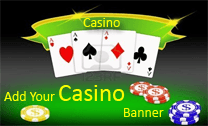Roulette is a casino and gambling game. A croupier turns around roulette wheel which has 37 or 38 separately numbered pockets in which a ball must land. The main pockets are numbered from 1 to 36 and change between red and black, with number 1 being red. In addition there is a pocket numbered 0 of green color. In most roulette wheels in the United States but not in Europe, there is a second zero compartment marked 00, also colored green.
If a player bets on a single number and wins, the payout is 35 to 1. The bet itself is returned, so in total it is multiplied by 36.
A player can bet on numbers, combinations, ranges, odds/evens, and colors.
History of Roulette
The first form of roulette was first devised in 17th century France, by the mathematician Blaise Pascal, supposedly inspired by his fascination with perpetual-motion devices. Later on, in 1842, fellow Frenchmen Francois and Louis Blanc added the "0" to the roulette wheel in order to increase house odds. Roulette was brought into the U.S. in the early 1800s, and again in order to increase house odds the second zero, "00", was introduced - although in some forms of early American roulette the double-zero was replaced by the American Eagle. In the 1800s, roulette spread all over both Europe and the U.S., becoming the most famous and one of the most popular casino games popular casino games. It is sometimes said that roulette is the "King of Casino Games", originally mostly because it was associated with the glamour of the casinos in Monte Carlo.
A legend tells about Francois Blanc, who supposedly bargained with the devil to obtain the secrets of roulette. The legend is based on the fact that if you add up all the numbers on the roulette wheel , the resulting total is "666", which is supposedly the "Number of the Beast" and represents the devil.
Types of Roulette
Generally, there are two types of roulette, the American roulette and the European roulette. The basic rules of the game are the same in both, the main difference being that in American roulette there are two "green numbers", zero and double-zero, thus increasing house odds, whereas in European roulette there is only the zero. There is also a difference in using chips in the two versions; American roulette uses so-called "non-value" chips, meaning that all chips belonging to the same player are of the same value determined at the time of the purchase and all chips belonging to one player are of the same value, and the player has to cash in the chips at the roulette table. European rulette uses standard casino chips of differing values as bets, which makes the game a little bit more confusing for the croupier and the players.
In traditional European roulette, the table is also much larger than in the American version, and the croupier uses a long tool called a rake to clear out the chips and to distribute winnings, whereas in American roulette the croupier does this by hand.
Bet odds table (American Roulette)
| Bet name | Winning spaces | Payout |
|---|---|---|
| 0 | 0 | 35 to 1 |
| 00 | 00 | 35 to 1 |
| 1 | 1 | 35 to 1 |
| 2 | 2 | 35 to 1 |
| 36 | 36 | 35 to 1 |
| Row 00 | 0, 00 | 17 to 1 |
| Row 3 | 1, 2, 3 | 11 to 1 |
| Row 6 | 4, 5, 6 | 11 to 1 |
| Row 9 | 7, 8, 9 | 11 to 1 |
| Row 36 | 34, 35, 36 | 11 to 1 |
| Column 1 | 1, 4, 7, ..., 34 | 2 to 1 |
| Column 2 | 2, 5, 8, ..., 35 | 2 to 1 |
| Column 3 | 3, 6, 9, ..., 36 | 2 to 1 |
| First 12 | 1, 2, 3, ..., 12 | 2 to 1 |
| Middle 12 | 13, 14, 15, ..., 24 | 2 to 1 |
| Last 12 | 25, 26, 27, ..., 36 | 2 to 1 |
| Odd | 1, 3, 5, ..., 35 | 1 to 1 |
| Even | 2, 4, 6, ..., 36 | 1 to 1 |
| Red | 1, 3, 5, 7, 9, 12, 14, 16, 18, 19, 21, 23, 25, 27, 30, 32, 34, 36 | 1 to 1 |
| Black | 2, 4, 6, 8, 10, 11, 13, 15, 17, 20, 22, 24, 26, 28, 29, 31, 33, 35 | 1 to 1 |
| 1 to 18 | 1, 2, 3, ..., 18 | 1 to 1 |
| 19 to 36 | 19, 20, 21, ..., 36 | 1 to 1 |
| five number bet | 0, 00, 1, 2, 3 | 6 to 1 |
Note also that 0 and 00 are neither odd nor even in this game.
The house average or house edge is what is lost on average relative to the bet. If a player bets on a single number in the American game there is a probability of 1/38 that the player gets 36 times the bet , so they end up having on average 36/38=0.9474 times the bet. Thus the house average for American roulette is 1/19 (5.26%); the same applies for the other kinds of bets, except for the five number bet where it is greater than 7%. The house average is approximately halved in the European game.
Number Trivia
Roulette has been known as the devil's wheel since the total of all numbers adds up to 666, the legendary number of the beast.
Betting Strategies and Tactics
Albert Einstein is reputed to have stated, "You cannot beat a roulette table unless you steal money from it."
And yet, the numerous even money bets in roulette have inspired many players over the years to attempt to beat the game by using one or more variations of a Martingale betting strategy, wherein the gamer doubles the bet after every loss, so that the first win would recover all previous losses, plus win a profit equal to the original bet. As the referenced article on Martingales points out, this betting strategy is fundamentally flawed in practice.
There is a common misconception that the green numbers are "house numbers" and that by betting on them one "gains the house edge." In fact, it is true that the house's advantage comes from the existence of the green numbers however they are no more or less likely to come up than any other number.
Various attempts have been made by engineers to overcome the house edge through predicting the mechanical performance of the wheel, most notably by Joseph Jaggers, the man who broke the bank at Monte Carlo in 1873. Claude Shannon, a mathematician and computer scientist best known for his contributions to information theory, built arguably the first wearable computer to do so in 1961 .
To try to prevent exploits like this, the casinos monitor the performance of their wheels, and rebalance and realign them regularly to try to keep the result of the spins as random as possible.
More recently Thomas Bass, in his book The Newtonian Casino 1991, has claimed to be able to predict wheel performance in real time. He is also the author of The Eudaemonic Pie, which describes the exploits of a group of computer hackers, who called themselves the Eudaemons, who in the late 1970s used computers in their shoes to win at roulette by predicting where the ball would fall.
In the early 1990's, Gonzalo Garcia-Pelayo, realizing that most roulette wheels are not "perfect", used a computer to model the tendencies of the roulette wheels at the Casino de Madrid in Madrid, Spain. Betting the most likely numbers, along with members of his family, he was able to win over one million dollars over a period of several years. A court ruled in his favor when the legality of his strategy was challenged by the casino.
In 2004, it was reported that a group in London had used mobile cameraphones to predict the path of the ball, a cheating technique called sector targeting. In December 2004 court adjudged that they didn't cheat because their special laser cameraphone and microchip weren't influencing the ball - they kept all £1.3m.
Famous Bets
In 2004, Ashley Revell of London sold all of his possessions, clothing included, and brought US$135,300 to the Plaza Hotel in Las Vegas and put it all on "Red" at the roulette table in a double-or-nothing bet. The ball landed on "Red 7" and Revell walked away with his money doubled to $270,600.



